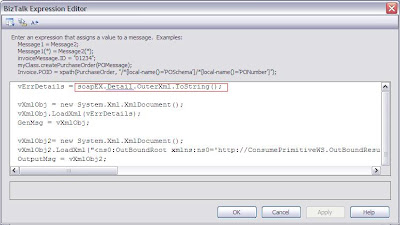Azure Logic Apps Naming Conventions whitepaper
23 hours ago
Technical blog for BizTalk, Sharepoint, SQL Server,SSIS and C#.net,ASP.net ..+++


Here I am using Reference.xsd schema to test this sample.
Before you call webMethod you need to pass the Soap Headers to the WebService Request. The orchestration Steps are
Here step1, 2 and 4 is easy. What about the step 3 ? what you need to write at Assignment Shape ?
Here is the code
vxmlObj = new System.Xml.XmlDocument();
vxmlObj= WsReferenceMsg;
SoapHeaderWsRequestMsg(SOAPHeaderTest.CustAuthHeader)=vxmlObj.InnerXml.ToString();
Note: SOAPHeaderTest.CustAuthHeaderà ProjectName.YourPropertySchemaRoot element.
Your final Orchestration should look like above image.
You can reach me at : raj.webjunky@yahoo.com





